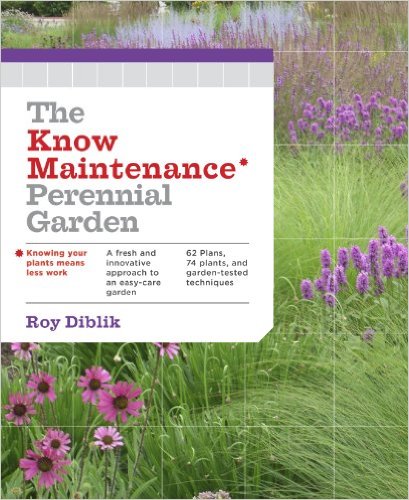 Everyone would like to have a beautiful garden with no maintenance so the title of Roy Diblik’s book, The Know Maintenance Perennial Garden, should catch the eye. But this is no ordinary maintenance free gardening guide; it is a whole new way of looking at perennials and garden design. Based on the idea of that gardeners should know their plants thoroughly, the book shows how a garden can be created as a mostly self-sustaining community. Although the focus is on perennials, once the approach is understood annuals, vegetables, herbs, shrubs, trees, and containers can be added to the plant communities.
Everyone would like to have a beautiful garden with no maintenance so the title of Roy Diblik’s book, The Know Maintenance Perennial Garden, should catch the eye. But this is no ordinary maintenance free gardening guide; it is a whole new way of looking at perennials and garden design. Based on the idea of that gardeners should know their plants thoroughly, the book shows how a garden can be created as a mostly self-sustaining community. Although the focus is on perennials, once the approach is understood annuals, vegetables, herbs, shrubs, trees, and containers can be added to the plant communities.
As an introduction to his The Know Maintenance approach to gardening, Diblik draws attention to some common practices that inhibit a plant’s full potential such as rototilling every new planting space, incorporating large amounts of manure and compost into every new planting space, and applying 2-4 inch of wood-chip mulch annually. He suggests that instead, we establish new gardening traditions that include looking to nature, keeping things simple, redefining the rules, and look for relationships that hold everything together. He begins with a chapter on evaluating the light, soil, and water potential of the garden site and continues with a guide for acquiring an intimate knowledge of plants. We all respond to the color of flowers, but their shape, fragrance, and arrangement on the stem, as well as the shape of the buds and seed heads, are all equally important. In the same way the color, shape, texture, arrangement, and the fragrance of leaves should be known especially as the leaves change from spring until fall. Stem shape, texture, color, and strength affect their usefulness in the garden. Even the roots deserve examination since they vary in thickness, density, color, and distribution in the soil, and are critical in the success of the plant. A chapter on care and maintenance includes a valuable description of thirteen common weeds that are particularly troublesome.
The bulk of the book is composed of sixty two garden plans and the plant profiles of the seventy four perennials used in the plans. The perennials were chosen primarily for dependability and are all suitable for the northern part of the country, primarily the Midwest, but many will grow in warmer areas. Each entry includes at least one picture, Latin and common names, simple description of the flower and foliage, seasonal growth rate, season of bloom, and growing conditions. The authors general observations are also included and suggestions are frequently made for combining with another plant. Plans for a space ten feet by fourteen feet in both sunny and shade areas are presented and can be considered modules for a larger or smaller garden. they can be divided, doubled, tripled or combined with other plans to fill most garden needs. The plans include maintenance notes and but no illustrations. Pictures or sketches of the plans with small insets featuring the plants would be very helpful and make this section of the book more user friendly.
The final chapters consider creating plant communities and a look at some of the well-known garden designers that have created gardens in the new style including Piet Oudolf, Noel Kingsbury, and Cassian Schmidt. Unfortunately, only one picture of one garden designed by each man is shown. Too bad, because such pictures could provide examples of the plant communities that are the focus of the book but shown only occasionally.
Diblik’s book makes a strong case for the Know Maintenance approach to gardening. It gives readers a sound foundation for understanding the approach and the knowledge needed to put it into practice. The result can be a beautiful self-sustaining garden based on ecological principles and requiring little maintenance. I strongly recommend this book for anyone interested in new ideas for creating and enjoying a garden.
Click HERE to buy The Know Maintenance Garden from Amaon.com